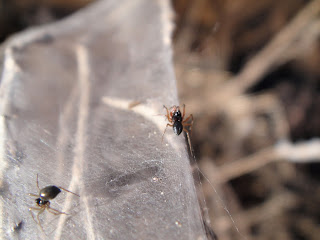There are some very small spiders (2.5 mm) out there that are so numerous they can create effects which you can see from a hundred feet away. Though you can barely see them, they can half fill the sky and the ground before you with their works.
Here's one, the Money Spider (Walckenaeria directa):
Here's another, the Scarlet Sheetweaver, (Florinda coccinea):
Here it is on Cheryl's finger nail to give you a better sense of the size.
The large visible (and often quite beautiful) effect they achieve depends upon the ability of probably millions of tiny creatures over a large area to magically coordinate and synchronize their activity. It's the kind of show that nature is so good at putting on.
Every few years late in the year, usually October or November, when conditions are just right (which means gently rising thermals) members of the large family Linyphiidae (the Dwarf Sheetweb Weavers) such as those pictured above, get out on the end of a twig, stick their butts up in the air, shoot out a few inches of web, and when the rising air picks up the web, the spider lets go, and is carried aloft. This is a standard operation for small spiders; it's called ballooning. They can't fly like insects, so they have developed this very efficient way to move great distances swiftly and effortlessly, and separate themselves from their siblings and find their own territory. What is different here is the number (millions) and the timing (all at the same time). A few hundred or thousand feet up their lines begin to tangle with the lines of others, and as the breezes whip them around the webs are self-woven into large cottony sheets. If you happen to look up in the air with your binoculars, you see the sky is half filled with these pure white skeins, that keep conglomerating into larger and larger sheets, six feet long or more. And then as the rising currents diminish they drift down and stick to telephone lines or cars or bushes or tall grass. (People with absolutely no souls may think it is a big sticky mess.)
We have seen this phenomenon (the dense webbing is called Gossamer) every few years around the Jonesboro area, though we have never studied it closely. But now we are studying spiders, so we hoped against hope we could finish 2013 with a big Gossamer year.
October passed, and no Gossamer. November passed the same. Finally December was over and all we could do is give up.
January 1st of 2014 we were driving dirt country roads in Lawrence County up past Pocahontas. Ponds were frozen over, skins of ice were along the edges of streams, for the past week temperatures had been below freezing every night. We came around a bend and saw the grass tops on the levee road above us shining white.
I had driven up onto the levee to photograph it (even though it was inside someone's property). Cheryl, waiting down on the road below outside the farm, said "Here comes the farmer fast in his pickup." I thought I would have to do some explaining, but in fact he was interested. "Where does the gossamer all come from?" He even called it by that name. He said it was all over the place, and we would see more of it along the road farther on down.
This picture is from the next patch. It was a bit more sheltered
from the beating wind which had made photography impossible up on the
levee.
Here's an example of how dense it is. It looked like tightly woven
sheets, yet I think it is the single lines of multitudes of ballooning
tiny spiders tangling together in the air, literally self-weaving.
And it was teeming with spiderlings (note the little seed-like dots).
All kinds of spiders. These are young wolf spiders.
A mixture of money spiders and others.
A male Scarlet Sheetweaver, one of the main perpetrators of these skeins.
The money spiders are another.
But many spider species just seemed to be along for the ride, perhaps
out ballooning on their own when they were caught up in the mass. The
larger spider in the foreground is a young Striped Lynx Spider.
An assortment of wolf and money and other spiders.
It looked like the main fallout had occurred a day or more ago, but they seemed to have survived the freezing temperatures. It was a nice way to finish the (slightly extended) last day of our first year (2013) of studying the spiders. And of course a nice first day of the 2014 spider season.













No comments:
Post a Comment